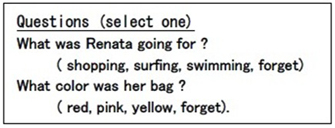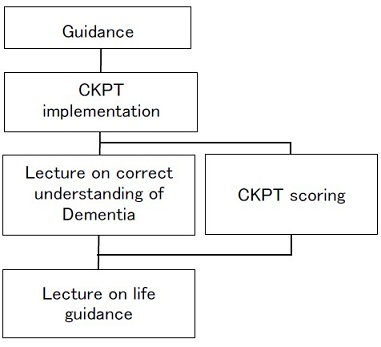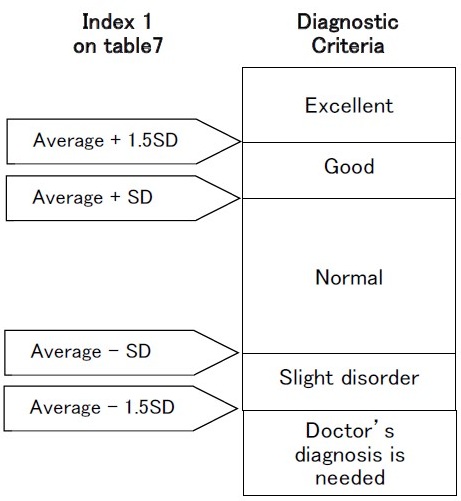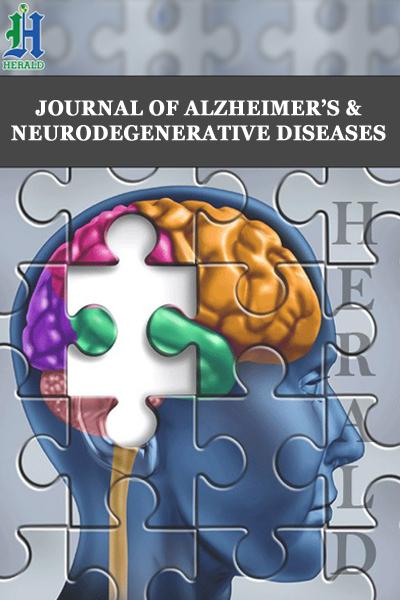
Derivation of Diagnostic Criteria for a Slight Cognitive Impairment using CKPT (Japanese Version of CWPT)
*Corresponding Author(s):
Takaki ShimuraBME Research Lab, Sosei Ltd., Japan
Tel:+81-53-525-8804,
Email:tshimura@tuba.ocn.ne.jp
Abstract
Objective: CWPT, which is able to detect a slight cognitive impairment in PCSD (Preclinical Stage of Dementia) or MCI (Mild Cognitive Impairment), is attracting attention as a neuropsychological test that allows screening at the stage where we must rely on expensive testing equipment such as PET, MRI and X-CT. CWPT is a test for identifying colors and remembering episodes while reading a story containing Color Words, so it can be easily translated and used in various languages. Therefore, the purpose of this paper is to show foreign researchers how to deriver the diagnostic criteria in Japan.
Methods: Diagnostic criteria were derived by analyzing large-scale data. At this time, since it is impossible to perform MMSE on all the subjects, CKPT was performed after receiving a report that I was normal. As shown in the evidence in the previous paper, the CKPT results show a normal distribution for each age, so a method to check the distribution by subjecting the subjects who disturb the normal distribution of the resulting histogram to trial and error is achieved.
Results: The total number of subjects used for the diagnostic criteria was 1325, and 199 subjects were excluded. The average value ± SD, and the average value ± 1.5SD were derived as the diagnostic criteria for male and female in their 60s, 70s, and 80s.
Conclusion: Using the derived diagnostic criteria, we have gained a foothold to develop various CKPT applications.
Keywords
CWPT; CKPT; Neuropsychologicaltest; PCSD; MCI; Slight disorder
HISTORY OF THE RESEARCH
Before the concept of MCI and PCSD was denominated in the field of dementia [1], our research started to detect slight declines in brain function. From the viewpoint of brain function measurement, the initially applied instruments were an electro encephalograph (ECG) and a near-inferred spectroscopy (NIRS [2]). Then, we reached the hypothesis that the slight decline in cognitive function should be measured as a decline in the prefrontal lobe, because the prefrontal lobe is the commander of human behavior.
As final goal was to find any methods used at the screening, I noticed neuropsychological tests instead of measuring instruments. Then color words discern test (CWDT) and Color words pick-out test (CWPT [3-7]) were invented.
In CWDT, color words are shown using different colors like Figure 1. Subjects should discern if the meaning and the printed color of the word is matched or not. If mismatched, make a cross (X) and if matched, make a circle (Ο). Although this test is an application of Stroop Test [8] which is well-known as one of the prefrontal lobe tests, it cannot totally extracts light declines of the prefrontal lobe functions.
 Figure 1: Sample of CWDT in English.
Figure 1: Sample of CWDT in English.
In CWPT, a story including color words are shown first like Figure 2A. Subjects should read the story memorizing he episode of it, and simultaneously pick-out color words discerning the matching of meaning and printed color of them. After a certain period of time, the subjects stop the task of determining the color words of Story, and answer Questions (Figure 2B) regarding the episode memorized without seeing Story. As explained above, CWPT is an improved version of CWDT with a short-term memory function examination.
 Figure 2A: Sample of Story of CWPT.
Figure 2A: Sample of Story of CWPT.
 Figure 2B: Sample of Questions.
Figure 2B: Sample of Questions.
After two presentations at international conferences [9,10], we published a paper [11] on the evidences of CWPT. Then we developed an English version of conducting CWPT and published a mini review [12] seeking collaborators who used it. Since the third international conference [13] was postponed due to the new coronavirus and the opportunity for announcement was lost, I decided to make that presentation on this paper.
OBJECTIVE
CWPT, which is able to detect a slight cognitive impairment in PCSD (Preclinical Stage of Dementia) or MCI (Mild Cognitive Impairment), is attracting attention as a neuropsychological test that allows screening at the stage where we must rely on expensive testing equipment such as PET, MRI and X-CT. CWPT is a test for identifying colors and remembering episodes while reading a story containing Color Words, so it can be easily translated and used in various languages. Therefore, the purpose of this paper is to show foreign researchers how to derive the diagnostic criteria in Japan.
METHODS
Essential consideration on data collection
Analytical data for deriving diagnostic criteria require uniformity and randomness in collection of analysis data. Uniformity means that the test tools used when applying CKPT to subjects are the same, that the testers who explain the subject using the tools are trained to be at the same level and that the environment in which the test is performed, such as the brightness and the distance from the adjacent subject, must meet certain criteria.
Randomness of data collection should be taken into consideration that the areas where the CKPT data was collected, are random such as urban areas and rural areas, and that the occupations of the subjects are varied.
Data collection method
As for the CKPT data collection method, Guidance, CKPT implementation, Lecture on correct understanding of dementia, Lecture on life guidance that does not fall into dementia, and CKPT scoring were performed according to the protocol shown in Figure 3, where CKPT scoring and Lecture on correct understanding of Dementia is done at the same time. What we devised is that the subjects can receive Lecture on life guidance while looking at their own results of CKPT.
 Figure 3: Protocol of data collection.
Figure 3: Protocol of data collection.
The right column is the venue where the subjects are, and the left column is the room where the supporters score.
Scouring method and Index1
The criteria for Story scoring are based on the following rules of Table 1.
|
Division |
Scoring criteria |
|
Correct answer |
Correct Ο or X is attached to color words |
|
Wrong answer |
Wrong Ο or X is attached to color words |
|
Oversight |
Color words that the subject forgets to attach Ο or X |
|
Mistaken answer |
Ο or X is attached to characters other than color words |
Table1: the criteria for Story scouring.
The diagnostic value Index1 of CKPT was obtained by multiplying the number of correct answers and the correct answer rate of episodic memory.
Selection of healthy people
Only the data of healthy subjects are required for analysis of the diagnostic criteria of CKPT. At the time of evidence examination [11], MMSE [14] was applied to all subjects, and the cut-off value was 27 points. However, large-scale data collection is required to obtain the diagnostic reference value, making it impossible to perform MMSE on all subjects. Therefore, we decided to exclude the person who says "I have no brain disorder" but disturbs the normal distribution by applying hisIndex1 to the histogram of his age. This work was accomplished by trial and error of exclusion and normal distribution examinations. Finally, the exclusion conditions are completed.
ETHICAL CONSIDERATION
For this paper, all subjects have agreed to use their data while keeping their personal information confidential.
RESULT
Analysis data collected
Total analysis data collected was 1325, and the breakdown of the regions is shown in Table 2. In the case of urban area, small cities and rural areas are mixed.
|
Regions |
Number |
|
Urban area of big cities (Tokyo) |
82 |
|
Urban area of middlecities (Hamamatsu, Okayama etc.) |
256 |
|
Small cities (Iwata, Fukuroi, Mishima etc.) |
559 |
|
Rural area |
428 |
Table 2: The breakdown of regions collected.
Exclusion and used data for analysis
Exclusion was performed by trial and error as shown in 3-4, and the exclusion conditions obtained from the examinations are summarized on Table 3. With regard to the task of adding Ο X to the color words of STORY, the exclusion conditions of Wrong answer, Oversights and Mistaken answer in Table 1 are shown. The condition of QUESTIONS for memory is where the correct answer is zero. The number of subjects excluded from collected data was 199, even if one of the exclusion conditions was met. Eventually, the number of subjects used in the analysis is shown in Table 4 by gender and age.
|
No. |
Items |
Conditions |
|
1 |
Story scoring |
Wrong answ. ≥2 |
|
2 |
Oversight ≥4 |
|
|
3 |
Mistaken answ.≥1 |
|
|
4 |
Wrong answ. =1 and Oversight ≥2 |
|
|
5 |
Questions |
No correct answer |
Table 3: Exclusion conditions.
|
Gender |
Age |
Number |
|
|
Sixties |
126 |
|
Seventies |
109 |
|
|
Eighties |
34 |
|
|
Female |
Sixties |
433 |
|
Seventies |
357 |
|
|
Eighties |
67 |
Table 4: Analyzed data.
Normality examination
Prior to analysis of diagnostic criteria, a normality test of the histogram of each group was performed. The examination was done using Shapiro-Wilk Test. The results are shown in Table 5. When the significance probability p shown in the table is less than 5%, it is judged as "not significantly following the normal distribution". If the opposite p is 5% or more, it is determined that “this data cannot be said not to follow a normal distribution”, that is, “follows a normal distribution”.
|
Gender |
Age |
Statistics |
Degrees of freedom |
Significance of probability p |
|
|
Sixties |
0.981 |
126 |
0.078 |
|
Seventies |
0.985 |
109 |
0.255 |
|
|
Eighties |
0.981 |
34 |
0.791 |
|
|
Female |
Sixties |
0.994 |
433 |
0.091 |
|
Seventies |
0.993 |
357 |
0.117 |
|
|
Eighties |
0.970 |
67 |
0.107 |
Table 5: Normality of Index1.
If p value is 0.05 or more, it follows normal distribution.
Diagnostic Criteria
Distribution parameter of Index1, such as the average value, the average value ± SD, and the average value ± 1.5SD, were calculated using the data shown in Table 5 whose normality was confirmed. It is shown in Table 6.
|
Male |
Average |
Average |
Average |
Average |
Average |
|
-1.5 SD |
-SD |
+ SD |
+1.5 SD |
||
|
Sixties |
5.1 |
7.3 |
11.7 |
16.1 |
18.3 |
|
Seventies |
5 |
7 |
10.7 |
14.4 |
16.2 |
|
Eighties |
3 |
4.9 |
8.6 |
12.3 |
14.2 |
Table 6: Distribution Parameter of Index1.
Average-1.5SD or less: 0.067, Average-SD or less: 0.159
|
Female |
Average |
Average |
Average |
Average |
Average |
|
-1.5 SD |
-SD |
+ SD |
+1.5 SD |
||
|
Sixties |
5.9 |
7.9 |
11.9 |
15.9 |
17.9 |
|
Seventies |
4.6 |
6.6 |
10.6 |
14.6 |
16.5 |
|
Eighties |
2.3 |
4.5 |
8.8 |
13.1 |
15.3 |
Table 7: Distribution Parameter of Index1.
Average-1.5SD or less: 0.067, Average-SD or less: 0.159
The diagnostic criteria using Index1 were set as shown in Figure 4 using Average ± SD and Average ± 1.5SD.In the figure, the values of Index1 which are shown in Table 7 are applied to derive the actual diagnosis criteria. For example, in the case of sixties male, if Index1 is 18.3 or more, it is Excellent, if Index1 is 16.1 or more and less than 18.3, Good, if Index1 is 7.3 or more and less than 16.1, Normal, and if Index1 is 5.1 or more and less than 7.3, Slight disorder, respectively. Furthermore, when Index1is less than 5.1, it is determined that doctor's diagnose is needed.
 Figure 4: Diagnostic criteria.
Figure 4: Diagnostic criteria.
SUMMARY
Following the procedure for deriving the diagnostic criteria for CKPT, the data collection of 1325 subjects, the extraction of subjects without brain disorder, and the examination of normal distribution were described in this order, and finally the diagnostic criteria were derived.
CONCLUSION
In this paper, the method of deriving the Japanese CWPT (CKPT) diagnostic criteria in Japan was described. We are looking for collaborators to spread CWPT in the world, and if you are interested, please refer to this derivation method and decide to give me e-mail. It is also noted that the English version of the CWPT test form, PowerPoint and manuals for the test are already prepared [14].
ACKNOWLEDGEMENTS
We would like to thank the Shizuoka Prefecture Life Support Center staff, Fukuroi City and Iwata City Elderly Welfare Division staff, and many other volunteers for their help in collecting and scoring this data. In addition, I would like to express my gratitude to Mrs. Atsuko Suzuki of BME Lab. in Sosei Limited Ltd. who has done reviewed all of scoring data.
REFERENCES
- Spering RA, Aisen PS, Beckett LA, Bennett DA, Craft S, et al. (2011) Toward defining the Preclinical stages of Alzheimer’s disease: Recommendations from the National Institute on Aging-Alzheimer’s Association Working-groups on diagnostic guidelines for Alzheimer’s disease. Alzheimers Dement 7: 280-292.
- Shimura T (2009) “Evaluation of CKPT using NIRS”. Prefrontal Lobe Measurement using Near Infrared Spectroscopy-Evaluation of Early Detection Methods and Rehabilitation Methods of Dementia. CORONA 113-118.
- Shimura T (2003) Japan Patent No. 4887720.
- Shimura T (2004) CN Ap. 200480020902. 6.
- Shimura T Germany Pt No.1641813.
- Shimura T UK Pt No.1649813.
- Shimura T Korean Pt No.0735647.
- Stroop JR (1935) Studies on interference in serial verbal reactions. Journal of Experimental Psychology 18: 643-662.
- Shimura T, Okuyama E, Osugi H (2018) A Neuropsychological test (CKPT: Color Word Pick-out Test) to be able to detect slight disorder of prefrontal lobe; Classify the level of the preclinical stage of dementia. The 24th International Conference on Neuroscience and Neurochemistry. Birmingham UK.
- Shimura T, Okuyama E, Osugi H (2019) A Neuropsychological test for Mild Cognitive Impairment and Preclinical Stage of Dementia. Global Conference on Oral Health & Mental Disorders, Rome Italy.
- Shimura T, Okuyama E, Osugi H (2019) CWPT(Color Words Pick-out Test) Available for Classifying the Slight Disorder on the Preclinical Stage of Dementia. HSOA Journal of Alzheimer’s and Neurodegenerative Diseases 5: 28.
- Shimura T, Okuyama E, Evans KT (2020) English Version of CWPT (Color Words Pick-out Test). Archives in Neurology & Neuroscience.
- Shimura T, Okuyama E, Osugi H (2020) A neuropsychological test (CWPT: Color Word Pick-out Test) to be able to be used for screening of PCSD and MCI of dementia. 5th International Conference on Brain & Spine, March 16-17, Kuala Lumpur, Malaysia.
- Folstein MF, Folstein SE, Mchugh PR (1975) “Mini-mental state”: A practical method for grading the cognitive state of patients for the clinician. Journal of Psychiatric Research 12: 189-198.
Citation: Shimura T, Okuyama E, Ohsugi H (2020) Derivation of Diagnostic Criteria for a Slight Cognitive Impairment using CKPT (Japanese Version of CWPT). J Alzheimer’s Neurodegener Dis 6: 046.
Copyright: © 2020 Takaki Shimura, et al. This is an open-access article distributed under the terms of the Creative Commons Attribution License, which permits unrestricted use, distribution, and reproduction in any medium, provided the original author and source are credited.

